The Vernier Go Direct Motion Detector: A Modern Twist on a Timeless Design
By Martin Horejsi
Posted on 2018-05-07
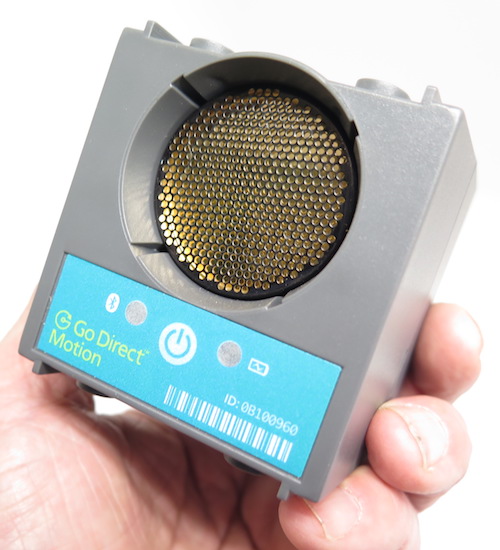
Vernier Software and Technology has introduced the next generation of its ultrasonic motion detector. While the gold circle sensor portion looks much like it’s previous five generations, the self-contained battery power source, the cubic form factor and most importantly the Bluetooth radio, are all new. But first some backstory.
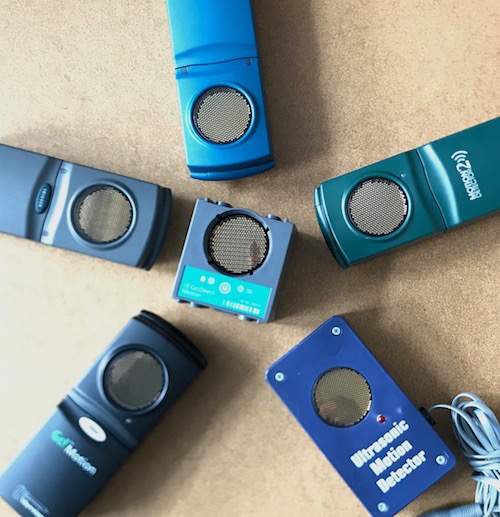
In 2008 I had the enormous pleasure of spending several days with Robert (Bob) Gilliland while at a Smithsonian Air and Space Award Ceremony where a team I worked with won the Smithsonian Air and Space Annual Achievement Trophy. Accepting the Lifetime Achievement Trophy that year was Joe Kittinger who brought his guest Mr. Gilliland. Joe Kittinger, by the way, is that guy who jumped out of a balloon in 1960 setting the world record for the highest skydive at 19 miles!
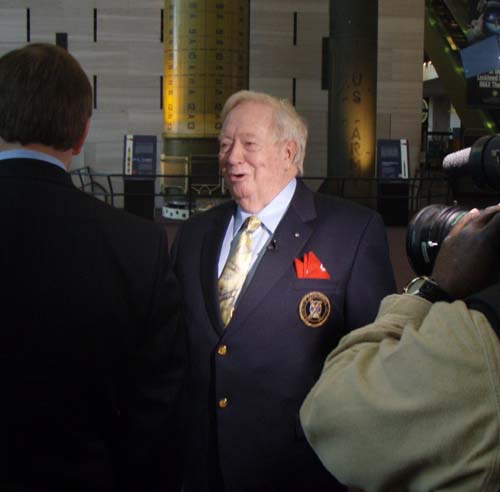
Joe Kittinger at press conference in National Air and Space Museum
That record stood until Felix Baumbartner broke it in 2012 (on the 65th anniversary of Chuck Yeager’s first breaking of the sound barrier) jumping from a height of 24 miles. Kittinger was the capsule communicator on Baumgartner’s Red Bull Stratos team. And speaking of records, Baumbartner’s jump was streamed live over the internet and the 9.5 million concurrent viewers set the record for the “live stream with the most concurrent views ever on YouTube.” I was on the team that helped set that record! It took almost ten million of us, but we did it! In the video below, you can hear Joe Kittinger talking Baumgartner through the jump a full 52 years after Kittinger set his jump record (something featured at the very end of the video).
Joe Kittinger’s friend Robert Gilliland was the chief test pilot for the SR-71 Blackbird, which is by far the coolest aircraft ever. The sleek titanium body with two stubby wings housing a pair of massive SCRAM Jet engines cruised at Mach 3 across much of the globe taking pictures and leaving awe. In fact when Gilliland took the very first Blackbird for its maiden voyage on December 22, 1964, he flew the plane up to 50,000 feet and at mach 1.5! No gentle spin around the desert, but straight into the supersonic sound-barrier breaking rarified air that was first experienced by Chuck Yeager in the Bell X-1 back in 1947. The precursor to the SR-71 was the Lockheed A-12, a similar looking aircraft that was one of many innovations to come out of Area 51. Yeah, that Area 51.
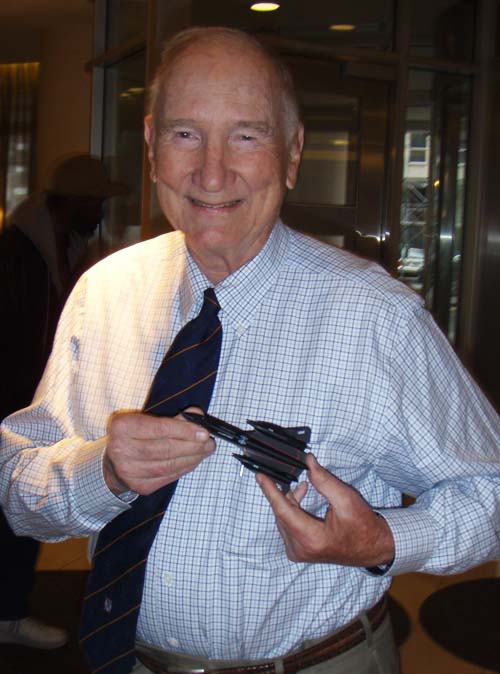
Robert Gilliland with model of the SR-71
For reference, the first chance anyone with means to ride on a supersonic commercial aircraft was in 1976 with the Concorde. Unfortunately the Concorde ceased operation in 2003 leaving few opportunities to fly supersonic on a whim. One option, however, is to go to Russia and explore their supersonic tourist offerings. Just imagine, “Supervised by our experienced test pilots, you will be exposed to the G force of the MiG-29‘s two mighty turbines. Up to 9 G of force will be exerted on your body. Have your body be pressed into the seat as you fly special maneuvers with the pilot, like rolls, loops, Immelman-turns and tail slides. These maneuvers though, inspired by real combat operations, are only the beginning. After some time in the air comes the big highlight: the pilot hands you over the controls for you to fly the MiG-29 all on your own!”
The speed and altitude with which the SR-71 flew was its only defense. It carried no armament, nor even enough fuel to get very far. A complex and extensive collection of refueling aircraft supported each long-range SR71 mission. So every so often, the SR71 dropped down from the future and slowed to a 400 mile-per-hour crawl where a mundane fuel tanker could pump gas into the Blackbird. And this is all before GPS. Bob Gilliland told me, “You’ve never been lost until you been lost at mach 3.”
In preparation for my Washington, DC trip to the award ceremony, I read Ben Rich’s 1994 book about Skunkworks titled Skunkworks. The book was about the unique operation at Lockheed’s Skunkworks that was responsible for innovations from the U2 spy plane (1955) to the SR-71 Blackbird (1964) to the Stealth Fighter (1980s). The book is one of the very few insider tomes chronicling world class innovation. Scary innovation. Like if Google built things out of molecules instead of computer code. Anyway, one of the stories in Rich’s book mentioned a rather amazing situation that has been argued online, even being a topic on the urban legend debunking website Snopes.com.
Rich wrote:
“Bats. Bats were the first visual proof I had that stealth really worked. We had deployed thirty-seven F117As [stealth fighter jets] to the King Khalid Air Base, in a remote corner of Saudi Arabia, out of the range of Saddam’s Scuds, about 900 miles from downtown Bagdad. The Saudis provided us with a first-class fighter base with reinforced hangars and at night the bats would come out and feed off insects. In the morning we’d find bat corpses littered around our airplanes inside the open hangers. Bats used a form of sonar to “see” at night, and they’re crashing blindly into our low-radar-cross-section tails. After all those years of training, we certainly believed in the product, but it was nice having that kind of visual confirmation, nevertheless.” pages 99-100.
A decade before Rich’s book about Skunkworks, Clarence L. “Kelly” Johnson wrote the book Kelly: More than my share of it all (1985). Kelly led Skunkworks through the production of those amazing planes including the U2 and the SR-71, two milestones of aviation that were created on Kelly’s watch. Bob Gilliland who of course worked with Kelly on the SR-71 signed my copy of Kelly’s book. Stories make science come alive, and I encourage all teachers to become part of those science stories whenever possible.

So what do bats and stealth fighter jets have in common? I think you are piecing together where this story is going. But one more twist…
Leonardo da Vinci sure got around. As if the Mona Lisa and all the experiments, artwork and discoveries he is known for are not enough, he also noticed that someone could listen for a ship by inserting a tube between the water and one’s ear. da Vinci’s observation was the beginning of a technology we call Sonar, which ultimately led to a technology for echo location, something that bats have been doing for millions of years.

Admire the background of the Mona Lisa. There is much going on behind the smile.
SONAR, or Sound Navigation And Ranging, is a navigation staple of nuclear submarines and bats. The two basic forms of Sonar are active and passive. If a machine or animal just listens, then it’s passive. If the creature or device emits a sound and then listens for a reflection (echo), then the Sonar is active. This seemingly minor difference in Sonars can have catastrophic consequences to ocean life, especially whales. When mechanical devices in the ocean like ships, submarines, and sensors using sonar, it can cause havoc on the organic SONAR and sound communication of many large mammals by disrupting their navigation and communication, and can even cause death through accelerated decompression by surfacing too fast.
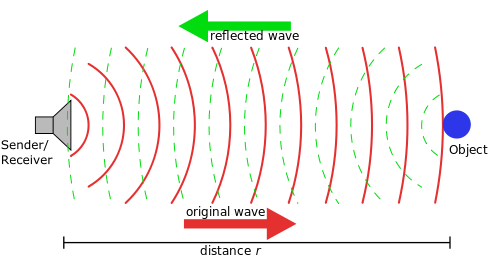
Some products are pretty much dialed in right away. They preform their magic with little complaint, and only evolve as greater connectivity co-evolves allowing them to communicate their information through the latest protocols. The Vernier motion detector is one of these initial-final-form sensors. But it had some help from the Polaroid cameras popular in the 1970s, in particular the Polaroid SX-70 Sonar autofocus camera. And speaking of consumer electronics evolution, there were at least 44 different models of the SX-70 camera and it still went extinct. Or did it? Seems there is not only a healthy market for SX-70 fossils on eBay, but also for resuscitated SX-70 cameras. Who knew? And for those with an appetite for minutia in this area, here is a wonderful article from the Physics Teacher about the ultrasonic Sonar systems.
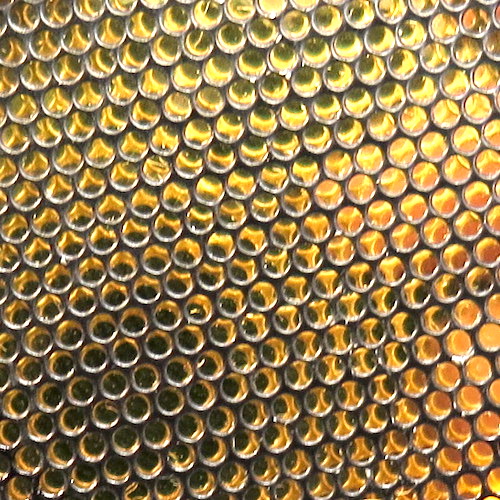
Edwin H. Land was the co-founder of Polaroid Corporation and is well known for many inventions including the Polaroid instant camera. First sold in 1948, the Polaroid instant camera produced a fully developed picture in under a minute. It was that instant development picture system that had a Sonar focusing system bolted onto it creating the SX-70 Sonar autofocus camera.
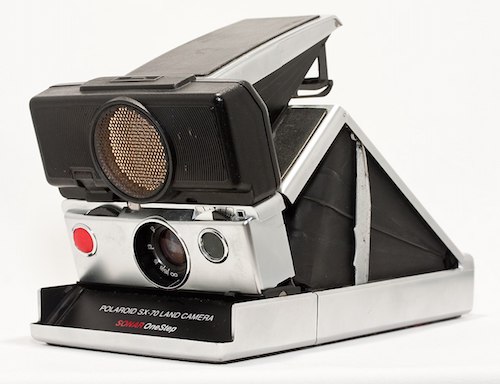
Polaroid SX-70 Sonar Land Camera (Wikipedia)
In the world of digital imaging, the Polaroid instant camera seems absolutely dinosauric. But Land’s reach was great and included assisting in the optical systems of the U-2 spy plane from none other than the Skunkworks shop at Lockheed. By the time the SR-71 was flying, the superb cameras aboard it could resolve an object a foot long while flying Mach 3 at 70,000 feet.
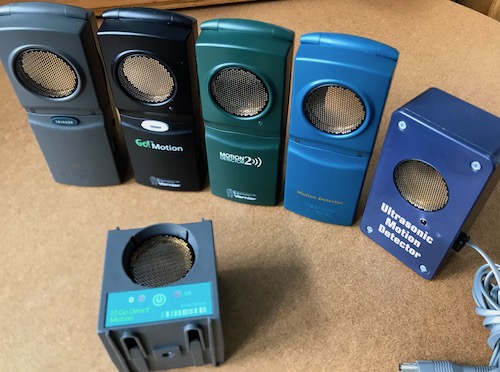
The Vernier Go Direct Motion Detector is the latest generation of ultrasonic motion detectors that resembles its 1990s ancestors yet operates with mid-21st century finesse and rigor. Ranging from 15 cm to 350 cm, the Vernier Go Direct Motion Detector is a no-frills cube about 6.5 cm per side that sends its motion detection data to a device through either Bluetooth or a cable. But the cable is like a throwback to the days when we had no choice but to rely on cables to connect our motion sensors. Like way back last year. While I write that in jest, the fact is that using the Bluetooth communication protocol speeds up and simplifies the use and application of the 276 cubic centimeters of Vernier Go Direct Motion Detector to the point that going back to a cabled sensor seems archaic and cumbersome.
One of the main reasons that the cord has become such a concern is that motion detectors are used in a bigger work envelope than most other sensors except perhaps for the Flow Rate Sensor that comes with a five meter cable (looking forward to a Bluetooth version of that sensor, by the way). Motion detection uses motion, and motion uses space, and space contains tripping hazards. The excitement of scientific exploration requires that teachers layout and run their classrooms with an eye on safety and success for both the students and the equipment. The more cords that can remain twist-tied and in the box, the better. But on the other hand, I can attest to the durability of the previous generations of ultrasonic motion detectors given how many of them slid off desks, chairs and benches during demonstrations and experiments.
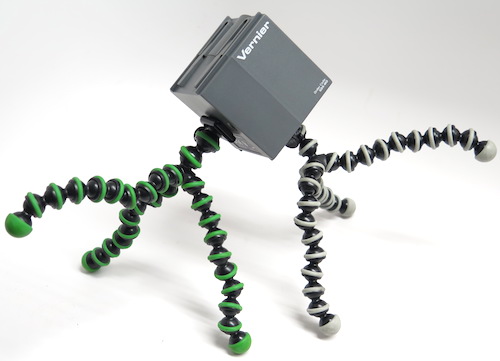
Two tripod sockets are found on the Vernier Go Direct Motion Detector with one 180 degrees from the sensor face, and of course the other 90 degrees rotated from the face since that is the only other reasonable side of the Vernier Go Direct Motion Detector cube. Or more simply, one socket on the back of the cube and one on the bottom. The sockets are invaluable for providing stability and aiming of the sensor. The 1/4×20 threads of the sockets will also screw onto any similarly threaded bolt allowing for a fixed platform for repeated experiments. The sensor with its wireless data transmission can also be attached to a spring thus inverting the common motion detection experiment where a bouncing weight is placed above the sensor.
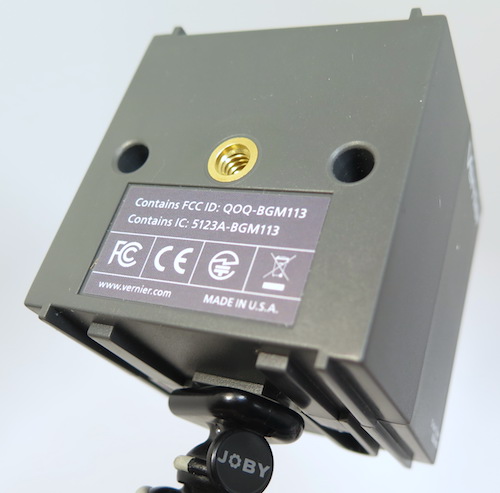
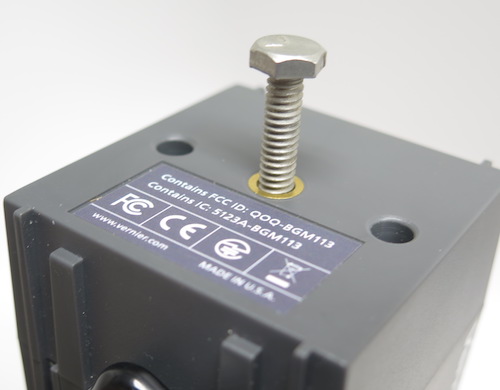
The way this sensor works is by emitting shorts bursts of ultrasonic sound waves. While the transducer behind the gold foil produces sound, it also listens for that same sound bouncing back. The time between the initial sound and the echo is used to extrapolate the distance between the sensor and the object based on the time and speed of sound. But in that give and take is less game of Marco Polo and more a precise dance between a single transducer that must both send out a sound and listen for a response. But how does one both speak and hear with the same organ at the same time without just listening to themselves?
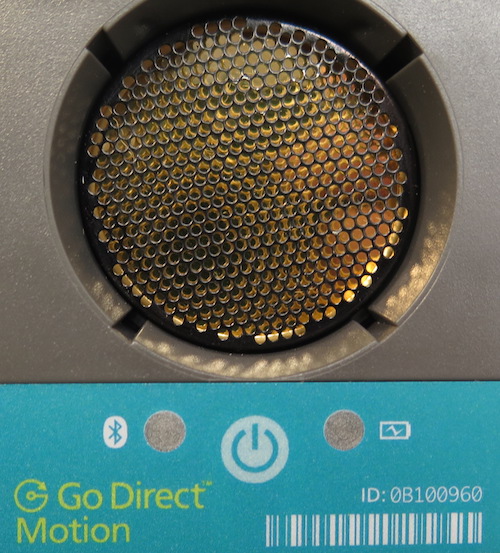
In the case of the Vernier Go Direct Motion Detector’s transducer, an ultrasonic “pulse train” of chirps is emitted, and then there is a pause allowing the gold foil covering the grooved plate of the transducer to stop vibrating. After 0.9 milliseconds, the listening begins. Sound travels about 30cm in that amount of time. That sets the absolute minimum distance the sensor can sense, also known as sensor’s blindspot. In this case a 30cm roundtrip or 15cm gap between sensor and object is the minimum reach of the Vernier Go Direct Motion Detector.
When the sensor operates there is an audible clicking about 50Hz which is obviously not ultrasonic since you can hear it. What is actually happening is that there are 50 pulse trains per second and the human ear can hear the overall set of ultrasonic pulses as a buzz but not the individual pulses. So each pulse is about 16 ultrasonic chirps, and there are 50 chirpsets per second. Is chirpset even a word? I had an epic battle with autocorrect telling me what I really meant to say was chipset so I must be on to something.
The Vernier Go Direct Motion Detector works through an interface running a version of Vernier’s Graphical Analysis 4 software whether computer, Chromebook, tablet, phone and to a limited extent Vernier’s own LabQuest 2.
For those more adventurous, one could read though the troubleshooting tips for the sensor and deliberately induce trouble. There are very real limits to the sensor, and those limits are also jam-packed with science. From materials to angles to distances to ultrasonic skipping, using the troubleshooting tips as a laboratory guide to experimentation, the sky’s the limit for the Vernier Go Direct Motion Detector. Well, not really (literally). But do you know what happens when you point a Motion Detector towards the sky? I’ll give you a hint, it’s not as cool as pointing an infrared temperature sensor skyward. Not even close. try it.
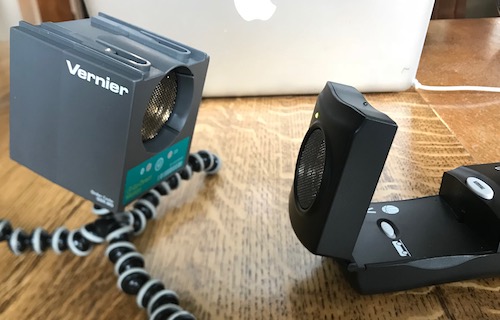
The mobility of the Vernier Go Direct Motion Detector opens up new channels of scientific inspection. Of course there is the highly accurate and fast motion detection, but there is also the ability to easily navigate materials and angles, and interference, and most anything else one can think of at the intersection of the Vernier Go Direct Motion Detector and sound material science (pun intended).
The number of transistors in a dense integrated circuit doubles every two years. Or so says Moore’s law. What we do with that integrated circuit, however, does not have to follow the law. Some new devices and applications take over the market making us wonder how we lived without it, while others go dark before the full moon shines twice. In the case of the Vernier Go Direct Motion Detector, we have the next obvious step in motion detection filled with echos from the past.
The word echo, by the way, stems from the story in Greek mythology about a cursed nymph who was doomed to only repeat the last words anyone spoke to her. My guess is today’s students will echo each other when using the Vernier Go Direct Motion Detector by repeating single words over and over like, “Cool” and “Wow!”
Disclaimer: The views expressed in this blog post are those of the author(s) and do not necessarily reflect the official position of the National Science Teaching Association (NSTA).


